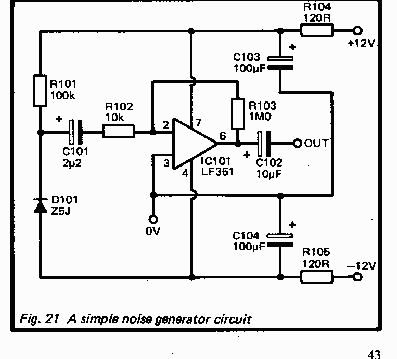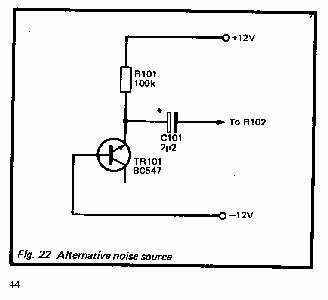<<- Back ^- Intro -^ Forward ->>
Chapter 2: Noise Generator
The Noise Generator
Noise Generator
Not all synthesisers incorporate a noise generator, but it is certainly a circuit which I would never omit from one. In this context the noise we are talking about is of the “white” noise type, which is the “hissing” sound that we normally try to avoid in electronic circuits. When suitably envelope shaped this basic noise sound can produce some interesting effects, but it is much more useful and versatile when used in conjunction with a VCF as well. A lot of percussive sounds can be synthesised, such as cymbal, handclap, and woodblock type sounds. By sweeping the filter from the envelope shaper some unusual but very worthwhile effects can be obtained. Another use of noise is in conjunction with a VCF which is set up to accurately track the pitch dictated by the keyboard. This enables melodies to be played on the noise generator/YCF combination provided the VCFs resonance control has been well advanced. A more conventional but similar use would be to mix the filtered noise with the VCO's output signal, and this can give some good pipe organ type sounds.
Figure 21 shows the circuit diagram of a noise generator based on a Z5J noise diode. This is fed from the two 12 volt supply lines via load resistor R101, and the total supply potential of 24 volts is sufficient to cause D101 to break down and avalanche like a zener diode. Also like a zener diode, a certain amount of noise is generated across the component, and this is coupled by C101 to a high gain amplifier based on IC101. This provides a voltage gain of about 4OdB (100 times), and this is needed because the noise. voltage generated across Dl, although higher than from an average zener diode, is still not very great. The amplified output from IC101 is about 7 volts peak to peak. Using a noise diode gives a good quality output with no significant bias to any frequency band within the audio range. R104, R105, C103, and C104 are used to provide additional smoothing of the two supply rails. This is necessary as the high closed loop gain of 1C101 leaves the circuit vulnerable to stray pick up of signals from the VCOs.
Noise diodes have the disadvantage of being relatively expensive and difficult to obtain. An inexpensive alternative is a silicon transistor connected as shown in Figure 22. Only the base and emitter terminals are connected, and these are connected so that the base - emitter junction is reverse biased. This results in the reverse breakdown voltage being exceeded, causing the junction to avalanche. It generates a fairly strong audio noise signal, but the typical output level is slightly less than that of a Z5J noise diode. It is adequate though, and it is not necessary to use any additional amplification. The noise purity is also likely to be not quite as good as when using a proper noise diode, but it is still perfectly adequate for most purposes.
Noise Generator Components (Fig. 21)
Resistors (all 1/4 watt 5%) R101 100k R102 10k R103 1M R104,105 120R Capacitors C101 2u2 63V radial electrolytic C102 10uF 25V radial electrolytic C103,104 100uF 16V radial electrolytic Semiconductors IC101 LF351 D101 Z5J noise diode Miscellaneous Circuit board 8 pin DIL IC holder, wire, etc.
Alternative Noise Source (Fig. 22)

